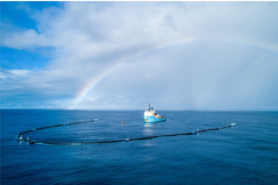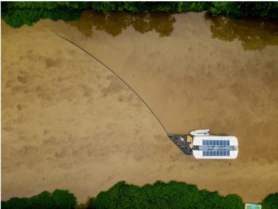Solutions to Oceanic Problems
Saving the oceans from plastic pollution
When Boyan Slat went diving in Greece during High School holidays in 2010, he saw more plastic than fish. This concerned him and that’s why he invented a device that should be able to remove plastic from the oceans for his High School end project in 2012. In his first year of college, at age 18, he decided that he was going to fully focus his attention on the realisation of his idea for cleaning the oceans. He quit his education and he founded an organization called The Ocean Cleanup.
The plastic problem
Every year, approximately 300 million tons of plastic is generated. A great portion of this ends up in the oceans. Large pieces of plastic in the oceans are gradually broken down in smaller particles known as microplastics (which are smaller than 5 millimetres). Microplastics in the sea is a problem because sea animals take in these plastic particles, having all kinds of harmful effects on the sea animals. Sometimes sea animals even die from the intake of microplastics. Through the consumption of seafood, the microplastics also enter our body. However, it is still unknown whether this has an effect on human health because it is a big challenge to detect microplastics.
The Ocean Cleanup
The Ocean Cleanup is a non-profit organization established in 2013. Its aim is to clean up 90% of the floating ocean plastic pollution by 2040 through technological developments. A crowdfunding campaign in 2014 resulted in over 2 million USD support, allowing the organization to make major steps forward. Since 2016, the Dutch Government facilitates the organization. One way of how the Dutch Government has facilitated The Ocean Cleanup was by allowing The Ocean Cleanup to test its prototype off the Dutch coast.
But the Dutch coast does not have a lot of plastic. For really cleaning up the oceans, ocean devices will be placed in the five garbage patches of the ocean. Almost all plastic in the oceans is situated in these garbage patches because ocean currents transport plastic from the coasts to these areas. Although the name garbage patch suggests that garbage patches are solid islands of thrash, this is not the case. The plastic is actually dispersed, forming trash fields. The largest garbage patch is the Great Pacific Garbage Patch (located between Hawaii and California). This ocean garbage patch has an area of three times the size of France and contains approximately 80,000 tons of plastic, which is equivalent to the weight of more than 43,000 cars.
Ocean device
The device that Boyan Slat invented for cleaning the oceans can be seen as a barrier. It consists of a 600-meter-long U-shaped floating pipe with a 3-meter-long screen underneath (see figure 1). The barrier is carried by winds, waves and currents, whereas the plastics in the ocean are only carried by currents. As a consequence, the barrier moves faster than the floating plastics. This causes the plastics to accumulate within the barrier. Every once in a while a boat collects the plastics within the barrier and brings it to shore. Currently, there is an ocean device successfully catching and collecting plastics at the Great Pacific Garbage Patch. It even catches microplastics as small as 1 mm.
River device
In 2017, Boyan Slat and his co-workers invented a new device, called the Interceptor, that would remove plastic as well, but here it concerns river plastic instead of ocean plastic. However, the device also helps us to a clean the ocean, because removing river plastics prevents new plastics from entering the oceans. Approximately 80% of the plastic waste in the oceans actually comes from rivers. The Interceptor consists of a barrier attached to a vessel (see figure 2). The barrier intercepts much of the plastic waste that comes by and transports it to containers on the vessel by means of a conveyor belt. Once the containers on the vessel are full, the Interceptor automatically sends a message to a local boat company. Someone from the local boat company subsequently brings a boat to transport the plastic waste from the vessel to shore. The Ocean Cleanup strives to tackle the 1000 most polluting rivers, which are responsible for about 80% of river plastics. However, at this moment, The Ocean Cleanup has only 3 three Interceptors deployed. The Interceptors can extract up to 50,000 kg a day.
Environmental impact
So, these two inventions form a solution to the plastic in the oceans, but some people are saying that the installations harm the surrounding ecosystems. Delphine Lobelle was asked about the environmental impacts. Lobelle is part of a research team at Utrecht University: tracking of plastic in our seas (TOPIOS). In the past, her team has worked together with the team of Boyan Slat. According to Lobelle, Slat’s team is doing everything they can to minimize the impact on the ecosystems. For example, the screen of the ocean device allows fish species to swim underneath the sytem. Moreover, before sending the ocean devices to the oceans, The Ocean Cleanup performs Environmental Impact Assessments. This entails that The Ocean Cleanup evaluates potential environmental risks of the systems and thinks of possible solutions.
However, according to Lobelle, there could be potential ways in which the Ocean Cleanup involuntarily harms ecosystems. The ocean device and the river device collect and remove all floating matter which might have long-term impacts on the ecosystems, but that can only be evaluated in the future.
So, The Ocean Cleanup is on the right track with removing plastics, but it still has a long way to go. According to Lobelle, it’s hard to say whether The Ocean Cleanup will attain their goal of cleaning up 90% of the floating ocean plastic pollution by 2040. Though the previous floating device alone would’ve struggled to reach this goal, she hopes that the Interceptors will substantially help to prevent plastic entering the ocean. Ultimately, only time can tell whether The Ocean Cleanup will reach its goal.

Figure 1. The ocean device. Retrieved from https://theoceancleanup.com/media-gallery/

Figuur 2. The Interceptor. Retrieved from https://theoceancleanup.com/media-gallery/
References
– Van Giezen, A., & Wiegmans, B. (2020). Spoilt-Ocean Cleanup: Alternative logistics chains to accommodate plastic waste recycling: An economic evaluation. Transportation Research Interdisciplinary Perspectives, 5, 100115.
– Holst, R. R. (2019). The Netherlands: The 2018 Agreement between The Ocean Cleanup and the Netherlands. The International Journal of Marine and Coastal Law, 34(2), 351-371.
– Markic, A., Gaertner, J. C., Gaertner-Mazouni, N., & Koelmans, A. A. (2020). Plastic ingestion by marine fish in the wild. Critical Reviews in Environmental Science and Technology, 50(7), 657-697.
– https://nos.nl/video/2249610-boyan-slat-van-profielwerkstuk-tot-plasticpionier.html
– https://www.rivm.nl/microplastics/onderzoek-naar-effect-van-microplastics-op-immuunsysteem

